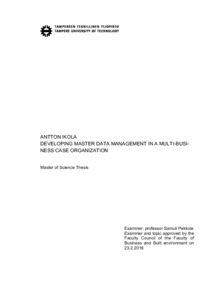Developing master data management in a multi-business case organization
Ikola, Antton (2018)
Ikola, Antton
2018
Tietojohtaminen
Talouden ja rakentamisen tiedekunta - Faculty of Business and Built Environment
This publication is copyrighted. You may download, display and print it for Your own personal use. Commercial use is prohibited.
Hyväksymispäivämäärä
2018-03-07
Julkaisun pysyvä osoite on
https://urn.fi/URN:NBN:fi:tty-201802231316
https://urn.fi/URN:NBN:fi:tty-201802231316
Tiivistelmä
Master data management (MDM) aims at creating and sustaining a single organization-wide unified data reference. In an organization which has multiple business units, this aim brings about many challenges. The challenges can be elaborated through the concepts of master data management, data governance and data architectures. Data governance addresses the roles and responsibilities, as well as common policies and procedures related to the creation, utilization, updating and archiving of master data objects. MDM architecture addresses how the data architecture is organized and in how centralized the actual technical solutions can be.
The goal of this thesis was to find out how to develop master data management in a multi-business case organization. The first phase concentrated on finding out how master data can be management in an organization through selected review of current academic literature. The empirical phase consisted of interviewing the organizations' different stakeholders at enterprise and subsidiary levels. This phase explored the question how master data is currently managed across the organization. The third phase was to identify needs, barriers and possibilities to develop different parts, as well as take into consideration the contingencies that enable effective master data management in a multi-business environment. Case study methods were used in order to have the breadth and depth that is required in providing answers to such complex and organization-specific research area.
The main findings of these research are concluded in three themes: different approaches to developing master data management, data governance and master data management architecture. Alignment of different levels of organization, their needs and different strategies, as well as harmonizing the business processes are important complements to the technical architecture. Therefore, MDM should not be treated as a IT problem, and data governance should not be seen as one size fits all solution. One of the most notable suggested actions of this research is, that the case organization should move towards a common enterprise architecture rather than pursuing separate subsidiary architectures and middle ground solution for MDM.
The goal of this thesis was to find out how to develop master data management in a multi-business case organization. The first phase concentrated on finding out how master data can be management in an organization through selected review of current academic literature. The empirical phase consisted of interviewing the organizations' different stakeholders at enterprise and subsidiary levels. This phase explored the question how master data is currently managed across the organization. The third phase was to identify needs, barriers and possibilities to develop different parts, as well as take into consideration the contingencies that enable effective master data management in a multi-business environment. Case study methods were used in order to have the breadth and depth that is required in providing answers to such complex and organization-specific research area.
The main findings of these research are concluded in three themes: different approaches to developing master data management, data governance and master data management architecture. Alignment of different levels of organization, their needs and different strategies, as well as harmonizing the business processes are important complements to the technical architecture. Therefore, MDM should not be treated as a IT problem, and data governance should not be seen as one size fits all solution. One of the most notable suggested actions of this research is, that the case organization should move towards a common enterprise architecture rather than pursuing separate subsidiary architectures and middle ground solution for MDM.
